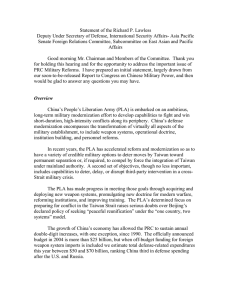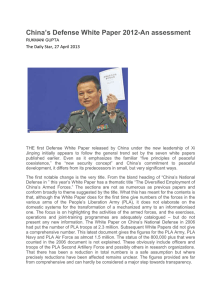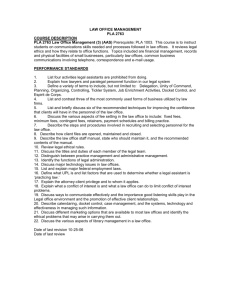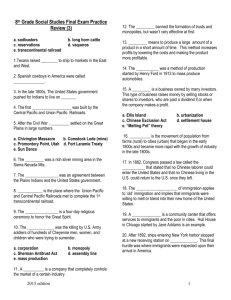The PLA In Search of a Strategic Focus
advertisement
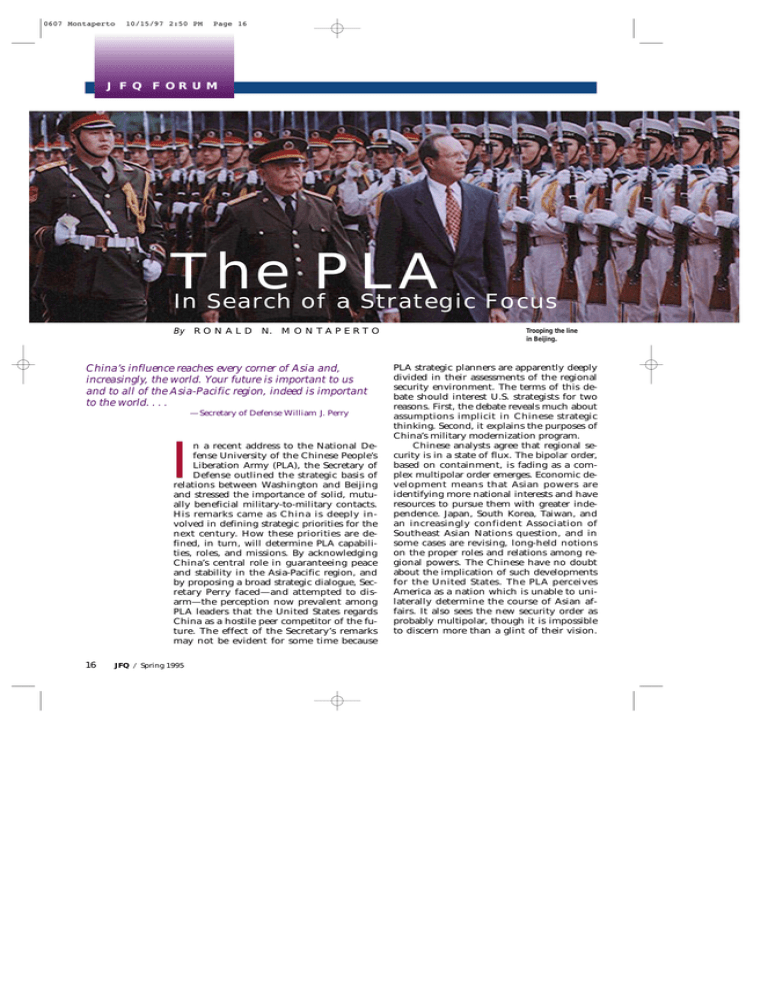
0607 Montaperto 10/15/97 2:50 PM JFQ Page 16 FORUM The PLA In Search of a Strategic Focus By R O N A L D N. M O N T A P E R T O China’s influence reaches every corner of Asia and, increasingly, the world. Your future is important to us and to all of the Asia-Pacific region, indeed is important to the world. . . . — Secretary of Defense William J. Perry I n a recent address to the National Defense University of the Chinese People’s Liberation Army (PLA), the Secretary of Defense outlined the strategic basis of relations between Washington and Beijing and stressed the importance of solid, mutually beneficial military-to-military contacts. His remarks came as China is deeply involved in defining strategic priorities for the next century. How these priorities are defined, in turn, will determine PLA capabilities, roles, and missions. By acknowledging China’s central role in guaranteeing peace and stability in the Asia-Pacific region, and by proposing a broad strategic dialogue, Secretary Perry faced—and attempted to disarm—the perception now prevalent among PLA leaders that the United States regards China as a hostile peer competitor of the future. The effect of the Secretary’s remarks may not be evident for some time because 16 JFQ / Spring 1995 Trooping the line in Beijing. PLA strategic planners are apparently deeply divided in their assessments of the regional security environment. The terms of this debate should interest U.S. strategists for two reasons. First, the debate reveals much about assumptions implicit in Chinese strategic thinking. Second, it explains the purposes of China’s military modernization program. Chinese analysts agree that regional security is in a state of flux. The bipolar order, based on containment, is fading as a complex multipolar order emerges. Economic development means that Asian powers are identifying more national interests and have resources to pursue them with greater independence. Japan, South Korea, Taiwan, and an increasingly confident Association of Southeast Asian Nations question, and in some cases are revising, long-held notions on the proper roles and relations among regional powers. The Chinese have no doubt about the implication of such developments for the United States. The PLA perceives America as a nation which is unable to unilaterally determine the course of Asian affairs. It also sees the new security order as probably multipolar, though it is impossible to discern more than a glint of their vision. 0607 Montaperto 10/15/97 2:50 PM Page 17 Montaperto DOD (Helene C. Stikkel) It is here that PLA analysts diverge in determining which regional relations will be the most influential. Some think that the evolution of the American partnership with Japan will be decisive. Conflicting priorities and competing interests between Washington and Tokyo will grow and act as a constant source of instability. Eventually, U.S.Japanese competition will be the fault line along which the region divides. Other analysts hold that relations between Washington and Beijing will drive regional events while still others think that the engine of change will be conflicts between rich and less affluent regional powers. Finally, a few analysts see a future shaped by American efforts to maintain a defining Asia-Pacific role despite a growing regional resistance to such a U.S. role. These analyses illustrate that Marxist dialectic—which assumes that a system is the product of contradictions between opposite forces—is pervasive among PLA strategic thinkers. Although communism is defunct as a basis of political economy, much less as a means of legitimizing over the last few years China’s the rule of the Chinese Communist Party, typiofficially published defense cal Marxist categories budget has roughly doubled of mind on international relations persist in the debate among PLA strategists. The thrust of Beijing’s security policies and the future PLA force structure will be directly shaped by this debate, which also is a context for interpreting military modernization. Over the last few years China’s officially published defense budget has roughly doubled. This development, coupled with aircraft purchases from Russia, an intransigent stand on territorial claims in the South China Sea, and a commitment to build a force projection capability, sparks universal concern among regional security planners. Whatever their disagreement may be over the future shape of the regional security system, Chinese strategists concur that a crucial juncture has been reached. In this light Beijing’s major security challenge lies not in Ronald N. Montaperto is a senior fellow in the Institute for National Strategic Studies at the National Defense University. He has served as an analyst with the Defense Intelligence Agency and taught at the U.S. Army War College. preparing to deal with a near-term military threat. Rather the problem is twofold: immediate and tactical on one hand, more broadly strategic and future-oriented on the other. Immediately and tactically, China is determined to maintain control over situations with the greatest potential for conflict. This means putting teeth in claims to sovereignty in the South China Sea and being able to enforce Chinese demands on Taiwan, although the Chinese remain sanguine about future developments in both areas. This leads to the other more broadly strategic and future-oriented dimension of the problem. Mindful of an uncertain future, Beijing must create an economy capable of supporting a range of economic, political, and military options that guarantee a major voice in the new structure and secure its place at the table. China’s relationship with the United States and other regional powers as well as the forces which the PLA is presently designing serve both imperatives. They can alert the region to China’s priorities as the security system unfolds. Military modernization in particular is a manifestation of Beijing’s commitment. Together these policies and programs ensure that China’s position is well-considered by other regional powers. The PLA is focused on strategic issues and concerns. In the near term, given the centrality of economic development and severe deficiencies in key military capabilities, Beijing will wish to avoid disrupting a regional stability that supports broad economic contacts. This might not apply, however, if the territorial dispute in the South China Sea altered the status quo or Taiwan declared its independence. In the long run the situation is less clear. Chinese strategists, like counterparts in other countries of the region, will continue to face ambiguities and uncertainties. Their approach will reflect a high degree of nationalism manifested through a determination to secure China’s role as a pivotal force in regional affairs. Much depends on policies implemented by the United States in concert with regional allies. Such policies can resolve uncertainties or exacerbate them. In any event, broad engagement with China and especially strategic dialogue with the PLA are essential to shaping regional security to support vital JFQ American interests. Spring 1995 / JFQ 17 0607 Montaperto 10/15/97 2:50 PM Page 18 U.S. PACIFIC COMMAND (PACOM) MISSION: PACOM has a four-fold mission: to foster peace, democracy, and freedom throughout the Pacific Ocean region; to deter conflict through forward presence and combat ready forces; to strengthen political, economic, and security cooperation; and to win in war should deterrence fail. PACOM stretches from the west coast of the Americas to the east coast of Africa and from the Arctic to the Antarctic, an area of responsibility which is more than 100 million square miles or roughly half of the earth’s surface. BACKGROUND: PACOM was among three unified commands—including Far East Command and Alaskan Command—established in the region in 1947. The Commander in Chief Pacific (CINCPAC) later absorbed the responsibilities of Far East South Korean sentry, Foal Eagle ’93. USS Tarawa at anchor in Hong Kong. 18 JFQ / Spring 1995 U.S. Navy (Jeff Hilton) U.S. Air Force (Mike Reinhardt ) 0607 Montaperto 10/15/97 2:50 PM Page 19 U.S. Air Force (Val Gempis) Australian guarding Rapier missile, Pitch Black ’93. Joint Combat Camera Center (Andy Dunaway) Combat Camera Imagery (Raymond T. Conway) Japanese Defense Agency (PACAF). In addition, PACOM has four sub-unified comCommand when it was disestablished in 1957. That mands: U.S. Forces Korea (USFK), U.S. Forces Japan same year PACOM service component commands (USFJ), Alaskan Command (ALCOM), and Special Operawere formed with their headquarters in Honolulu tions Command Pacific (SOCPAC); it also has two standand CINCPAC headquarters were transferred to ing joint task forces (JTFs): Joint Interagency Task ForceCamp H.M. Smith near Pearl Harbor. Army, Navy, West (formerly JTF-5), stood up in and Air Force components re1989 to conduct counterdrug operaported to CINCPAC and the tions, and JTF-Full Accounting, formed Marines, under a type commander, to Japanese Maritime Self-Defense Force in 1992 to investigate the missing in Commander in Chief Pacific Fleet. ships. Southeast Asia. Due to the extent of command reIn 1972 PACOM took responsisponsibilities, CINCPAC was relieved of bility for U.S. forces in the Indian direct command of Pacific Fleet in Ocean, Southern Asia, and Arctic area 1958, although Deputy CINCPAC had under a worldwide unified command previously assumed de facto comrealignment. To the north, the command. Command relations were mand also assumed responsibility for further realigned by the DOD a portion of the Arctic Ocean and Reorganization Act of 1958 with Aleutian Island chain formerly under combat-ready forces placed Alaskan Command. The Pacific coastunder the operational command line of South America became the reof CINCPAC. PACOM has four component commands today: sponsibility of Atlantic Command which took responsibility for all ocean U.S. Army Pacific (USARPAC); areas fronting South America. U.S. Pacific Fleet (PACFLT), ALCOM, a sub-unified command formed in 1989, has including U.S. Fleet Marine Forces, Pacific responsibilities for the land, sea, and air defense of (FMFPAC); U.S. Marine Corps Forces, Pacific Alaska, including the Aleutians and surrounding wa(MARFORPAC); and U.S. Pacific Air Forces ters—less the air defense mission of the Alaskan region of North American Aerospace Defense Command (NORAD). Moreover, the PACOM area was expanded in Thai helicopter, 1976 to include the east coast of Africa. Cobra Gold ’94. The combined commands in the region are United Nations Command (UNC) and Republic of Korea/U.S. Combined Forces Command (CFC), both with headquarters collocated with USFK in Seoul. UNC is charged with oversight of the Armistice agreement of 1953 to preserve peace in Korea; CFC was established in 1978 to oversee bilateral military operations. JFQ Russian MI–8 during combined search and rescue exercise. Spring 1995 / JFQ 19
